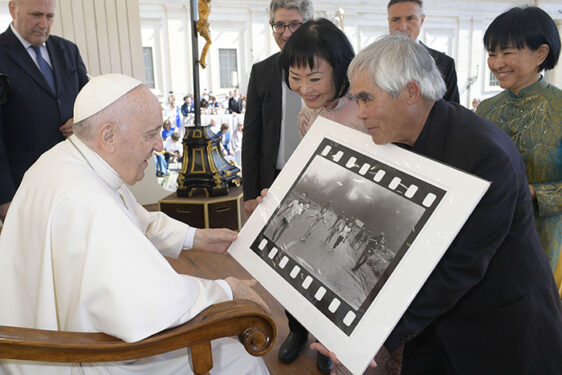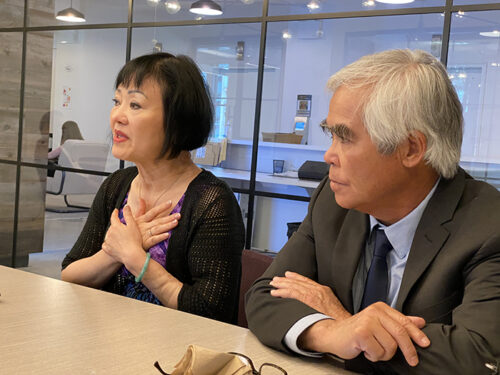
MANHATTAN — On June 8, 1972, Nick Ut was a Vietnamese photographer covering a battle 25 miles northwest of Saigon when he saw an attack bomber drop napalm on the village of Trảng Bàng.
“First it’s burning red, the fire,” said Ut, who was 20 at the time. “Then you see black smoke, and then white smoke. At first, I didn’t believe there were any people in there, after the napalm. But then I see people running out of the white smoke.”
A 9-year-old girl with outstretched arms — naked after shedding her flaming clothes — screamed, “Nóng quá! Nóng quá!” (Too hot! Too hot!) Severe burns covered her left arm and back.
Ut’s photo of the child was carried by his employer, The Associated Press. Titled “The Terror of War,” it won the 1973 Pulitzer Prize for Spot News Photography.
And the subject of the photo, Phan Thị Kim Phúc, got the unfortunate nickname “Napalm Girl.”
As Ut recently recounted the harrowing incident, Phúc sat quietly beside him, with her eyes shut. She clutched a tissue, which she used to dab a tear.
Then she spoke, describing her second brush with death as a young adult. Mired in isolation and depression, she contemplated suicide.
“But God had a plan,” she said with a beaming smile. “Fifty years later I am still living an amazing miracle. Because nobody understands the story behind that picture — what happened to that little girl. My life became so much darkness.”
‘Chronic Pain’
Phúc and Ut have told the story countless times, and they did so again, Monday, June 6, in the conference room of an office building on 5th Avenue in Manhattan.
The lifelong friends — she calls him “Uncle Ut” —have traveled the world sharing the story. On May 11 they had an audience with Pope Francis at the Vatican.

Their stop in New York commemorated the 50th anniversary of “The Terror of War” — widely known as one of the most iconic and influential photos of human conflict. They also spoke at an evening lecture, “Napalm Girl 50 Years Later,” at the Fotografiska Museum of photography.
Ut recalled how he snapped around 30 photos of the carnage, but then realized Phúc’s burns were life threatening. He dropped his expensive cameras — two Leicas and a pair of Nikons — and tried to help her.
“I didn’t care about gear anymore,” he said. “I wanted to get her into the car; I knew she’d be dying. Nobody thought she’d make it. No way.”
Phúc said she remembers very little about fleeing the fire; she doesn’t remember seeing Ut on that day. The photographer said he was amazed to learn she survived.
‘I Hated You’
The Vietnam War ended in 1975, but Phúc endured chronic pain into her adulthood — physical and emotional. Her schoolmates recoiled from the disfigurement left by her scars. As Ut’s photo became increasingly famous, she felt more alone, friendless, and misunderstood.
Over time she developed a list of “enemies,” starting with the South Vietnamese pilot of the A-1 Skyraider that dropped the napalm. Next came the government officials who took her out of school to exploit her scars for anti-Western messaging, which delayed her hopes for higher education.
“I had so many enemies, including myself,” she said. “I hated my life. And I hated everyone who caused my suffering. It doesn’t matter who you were, if you caused my suffering, I hated you.”
The list grew to include Ut for taking the photo that showed her nakedness to the world. She gave him a pat on the shoulder and admitted, “I hated him, too, because he took the picture that made my life such a disaster.”
“Then,” she added, “my thoughts of suicide came along. I didn’t want to live anymore. I wanted to disappear.”
‘The Way, the Truth, and the Life’
Meanwhile, Phúc stumbled upon a copy of the New Testament of the Bible in a library in Ho Chi Minh City — the former Saigon.
“The more I read, the more questions I had,” she said. “I read John 14:6, when Jesus said, ‘I am the way, the truth, and the life — no one can come to the Father, but by Me.’ I thought, ‘What? Why is that?’
“I looked up at the sky, and with all my heart and soul, I cried out, ‘God, are you real? Do you exist somewhere? Please help me!’ Because at that time I was really isolated, really lonely.”
Although the Socialist Republic of Vietnam is an atheist state as declared by its government, churches do exist, and Phúc found one through her brother-in-law’s cousin — a Christian.
The message of salvation through Jesus Christ intrigued her, right up to the part about forgiving your enemies. “I thought, ‘No way. How can I? I am a human being,’” she said.
The answer, she learned, was to pray for her enemies. She gave it a try, and it worked.
“My enemies list became my prayer list,” Phúc said. “And the more I prayed, the softer my heart became. It was transformative from darkness into light.”
Well-Known to Pope Francis
Phúc eventually went to Cuba to study medicine. There, she met another Vietnamese student and her future husband, Buy Huy Toan.
The couple married in 1992 and settled in Ontario, Canada, where they received political asylum and citizenship. They raised two sons and became grandparents.
Phúc now uses her “Napalm Girl” notoriety to promote peace and forgiveness, and medical care for children injured in war. She is a UNESCO goodwill ambassador.
While in Cuba she learned Spanish, which came in handy last month during her audience with Pope Francis.
Earlier this year, Ut had an exhibition of his work in Milan, during which he asked to meet the pope and gift him with a copy of “The Terror of War.”
The Vatican eagerly agreed, Ut said, so the Holy Father invited Phúc, who came with her husband.
Pope Francis, like the rest of the world, knew the photograph, and Phúc as well, having met her when she visited his native Argentina before he was pope. She did not remember that, until he addressed her in Spanish.
“He said, ‘I know you,’” Phúc recalled. “Then he said, ‘Do you remember we met before in Buenos Aires?’” Finally she did remember.
“I said, ‘May God bless you with good health for all you have done for peace,’” she said. “He said, ‘Thank you.’ And it was just such a happy moment because he remembered me.
“I just couldn’t imagine,” Phúc said.

